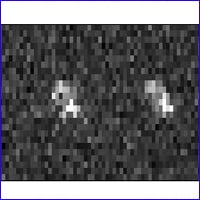In case you had any doubts, it's now official: Asteroid 2007 TU 24 will not impact or have any affect on Earth. Astronomers have obtained the first images of the near earth asteroid using high-resolution radar data. "With these first radar observations finished, we can guarantee that next week's 1.4-lunar-distance approach is the closest until at least the end of the next century," said Steve Ostro, Jet Propulsion Laboratory astronomer and principal investigator for the project. "It is also the asteroid's closest Earth approach for more than 2,000 years."
The radar images indicate the asteroid is somewhat asymmetrical in shape, with a diameter roughly 250 meters (800 feet) in size. Asteroid 2007 TU24 will pass within 1.4 lunar distances, or 538,000 kilometers (334,000 miles), of Earth on Jan. 29 at 12:33 a.m. Pacific time (3:33 a.m. Eastern time). So, while this image is pretty faint, (about 20 meters per pixel) as the asteroid gets closer, NASA will be able to obtain better images and more details about the object.
And just to repeat for anyone who still has any doubts, the scientists at NASA's Near-Earth Object Program Office at JPL have determined that there is no possibility of an impact with Earth in the foreseeable future.
Asteroid 2007 TU24 was discovered by NASA Oct. 11, 2007. The asteroid should be visible to amateur astronomers using 3 inch (7.6 centimeter) telescopes. It will be brightest on January 29-30, reaching an approximate apparent magnitude of 10.3, and then become fainter as it moves farther from Earth. Anyone looking for the asteroid with amateur telescopes will need dark and clear skies. An object with a magnitude of 10.3 is about 50 times fainter than an object just visible to the naked eye in a clear, dark sky.
NASA detects and tracks asteroids and comets passing close to Earth. The Near Earth Object Observation Program, commonly called "Spaceguard," discovers, characterizes and computes trajectories for these objects to determine if any could be potentially hazardous to our planet. They use several different tracking devices including the Goldstone's 70-meter diameter (230-foot) antenna that is capable of tracking a spacecraft traveling more than 16 billion kilometers (10 billion miles) from Earth.
Ostro and his team plan further radar observations of asteroid 2007 TU24 using the National Science Foundation's Arecibo Observatory in Puerto Rico on Jan. 27-28 and Feb. 1-4.
Original News Source:
JPL Press Release
 Universe Today
Universe Today
